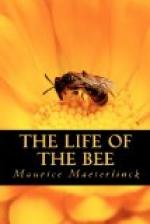When satisfied, she flew away and returned to the hive. I followed, saw her pass over the surface of the crowd, plunge her head into an empty cell, disgorge her honey, and prepare to set forth again. At the door of the hive I had placed a glass box, divided by a trap into two compartments. The bee flew into this box; and as she was alone, and no other bee seemed to accompany or follow her, I imprisoned her and left her there. I then repeated the experiment on twenty different bees in succession. When the marked bee reappeared alone, I imprisoned her as I had imprisoned the first. But eight of them came to the threshold of the hive and entered the box accompanied by two or three friends. By means of the trap I was able to separate the marked bee from her companions, and to keep her a prisoner in the first compartment. Then, having marked her companions with a different colour, I threw open the second compartment and set them at liberty, myself returning quickly to my study to await their arrival. Now it is evident that if a verbal or magnetic communication had passed, indicating the place, describing the way, etc., a certain number of the bees, having been furnished with this information, should have found their way to my room. I am compelled to admit that there came but a single one. Was this mere chance, or had she followed instructions received? The experiment was insufficient, but circumstances prevented me from carrying it further. I released the “baited” bees, and my study soon was besieged by the buzzing crowd to whom they had taught the way to the treasure.
We need not concern ourselves with this incomplete attempt of mine, for many other curious traits compel us to recognise the existence among the bees of spiritual communications that go beyond a mere “yes” or “no,” and that are manifest in cases where mere example or gesture would not be sufficient. Of such, for instance, are the remarkable harmony of their work in the hive, the extraordinary division of labour, the regularity with which one worker will take the place of another, etc. I have often marked bees that went foraging in the morning, and found that, in the afternoon, unless flowers were specially abundant, they would be engaged in heating and fanning the brood-cells, or perhaps would form part of the mysterious, motionless curtain in whose midst the wax-makers and sculptors would be at work. Similarly I have noticed that workers whom I have seen gathering pollen for the whole of one day, will bring no pollen back on the morrow, but will concern themselves exclusively with the search for nectar, and vice-versa.
[48]




